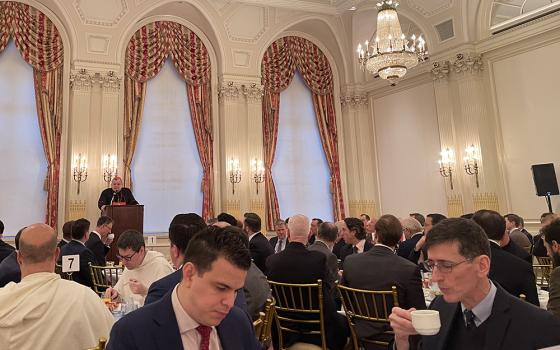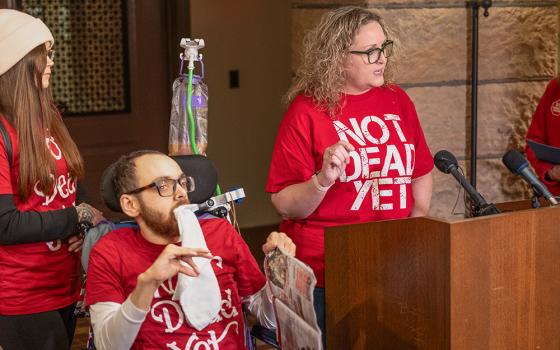By JOHN L. ALLEN JR.
Los Angeles
Describing it as an example of “Hallmark card ecclesiology,” a Hispanic Catholic theologian today criticized a recent decision of the United States Conference of Catholic Bishops to collapse ministries for various ethnic groups, such as Hispanics, Asians, and African-Americans, into one office for “cultural diversity.”
“It’s a profound loss of agency for those already underrepresented in the church and its mission,” said Carmen M. Nanko-Fernández, who teaches at the Catholic Theological Union in Chicago. She described the move as risking an “erasing of identities” into an “undifferentiated sameness,” which will “dilute the particular experiences and sensitivities” of the various groups.
“This places over half of the Catholic Church in the United States under the aegis of one office, with no apparent plans to increase staff,” she said, calling the move “short-sighted.”
The danger, she said, is that ethnic groups within the church such as Hispanics may be regarded as “like salsa – colorful and flavorful, but not necessary.” Yet increasingly, she said, in American Catholicism, “Latinos are the Catholic norm.”
Nanko-Fernández spoke as part of a panel on feminist ecclesiology at the opening of a conference of the Catholic Theological Society of America, the largest annual gathering of theologians in the United States, in Los Angeles.
Noting that Hispanics today represent an estimated forty percent of the Catholic population in the United States, and a majority of younger Catholics in the county, Nanko-Fernández argued that “shifting demographics” require a deeper response from the bishops.
She observed that during the bishops’ meeting in November 2006, when they issued an eight-point pastoral program, point five originally referred only to “cultural diversity.” Under pressure from Hispanic bishops, especially Archbishop Jose Gomez of San Antonio, that was amended to “cultural diversity, especially Hispanic ministry in the spirit of Encuentro,” referring to gatherings of pastoral leaders involved with the Hispanic community.
“At one level, this seems a monumental step forward for Hispanic ministry,” Nanko-Fernández said. But the reductions in both staff and organizational presence, she suggested, belie the promise of that statement. Nanko-Fernández noted, for example, that the bishops’ longtime staffer on Hispanic ministry, Ronaldo Cruz, is leaving the conference after 23 years in the job.
Jamie T. Phelps, who teaches at Xavier University in Louisiana and directs the Institute for Black Catholic Studies there, spoke about what she sees as a recent evolution in women’s representation in church ministries.
Phelps said that despite what she called “shadows” in Pope John Paul II’s 1988 apostolic letter on women, Mulieres dignitatem, there are positive elements in the letter, , including its strong support of “the right of women to full human development” as well as “Jesus’ refusal to participate in the discrimination against women of his day.”
In this regard, Phelps referred to attempts by the U.S. bishops to draft a pastoral letter on women in the mid-1980s and early 1990s. After bruising debates that led to four different drafts, as well as a two-day session at the Vatican in the fall of 1991 led by then-Cardinal Joseph Ratzinger, the last draft was voted down by the bishops in fall 1992, and the project died.
Phelps said that in retrospect, it might have been better for the bishops to adopt what she regarded as an imperfect text, so that at least “we would have something to debate.”
“We have to recognize that in our humanness, we are limited,” Phelps said. “If we look for the perfect text, we’ll never say anything.”
Without ever broaching the issue of women’s ordination to the priesthood directly, Phelps said that the experiences of recent years, including the growing presence of women as lay ecclesial ministers, have “prepared people for ordained women.”
“If it had happened thirty years ago, there would have been resistance,” she said. “There was resistance when women began reading at Mass. There was resistance when women began holding positions in dioceses.”
Phelps described the current position of the church as “no” to ordination, but “yes” to participation in ministry.
Natalia Imperatore-Lee of Manhattan College suggested that ecclesiological reflections of Sr. Elizabeth Johnson could be combined with elements of the story of the Our Lady of Guadalupe devotion in Hispanic culture to promote a more “inclusive” ecclesiology.
Quoting Hispanic theologian Virgilio Elizondo, Imperatore-Lee noted eventually that in the Guadalupe story, the “convert” is not the peasant visionary Juan Diego, but the bishop, who eventually acknowledges the legitimacy of the account.
Moreover, Imperatore-Lee said, it’s important that the shrine to Our Lady of Guadalupe had to be built on the spot where the vision took place, the Hill of Tepeyac.
“The institutional church had to go out to the poor,” she said. “The center of Catholicism had to go out to the margins, and the margins were thereby brought to the center.”
Imperatore-Lee then discussed Johnson’s vision of “ordinary” holiness, in contrast to the exceptional instances of holiness usually reflected in the saints officially canonized by the church.
“Maybe what the church needs, and what women can bring to our notions of authority and holiness, is putting the ordinary at the center,” Imperatore-Lee said.
In response to a question, Nanko-Fernández said that she “can’t worry about lay ecclesial ministry, because our faces aren’t represented.” Noting that while Hispanics may be forty percent of the Catholic population in the United States, only eight percent of the country’s bishops are Hispanic, and the majority of Hispanics are in parishes led by non-Hispanic clergy. Similar disparities, she said, apply to lay ministers. Those who are Hispanic, she said, are typically volunteers without professional training, because Hispanics are under-represented in graduate ministry programs.
Nanko-Fernández cited a recent study by the Pew Trust of religious patterns among Hispanics which found that the majority go to church within twenty minutes walking distance from their homes, and argued that “this should have consequences as we think about parish closings.”




